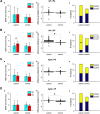Evidence for Subcortical Plasticity after Paired Stimulation from a Wearable Device
- PMID: 33441436
- PMCID: PMC7896019
- DOI: 10.1523/JNEUROSCI.1554-20.2020
Evidence for Subcortical Plasticity after Paired Stimulation from a Wearable Device
Abstract
Existing non-invasive stimulation protocols can generate plasticity in the motor cortex and its corticospinal projections; techniques for inducing plasticity in subcortical circuits and alternative descending pathways such as the reticulospinal tract (RST) are less well developed. One possible approach developed by this laboratory pairs electrical muscle stimulation with auditory clicks, using a wearable device to deliver stimuli during normal daily activities. In this study, we applied a variety of electrophysiological assessments to male and female healthy human volunteers during a morning and evening laboratory visit. In the intervening time (∼6 h), subjects wore the stimulation device, receiving three different protocols, in which clicks and stimulation of the biceps muscle were paired at either low or high rate, or delivered at random. Paired stimulation: (1) increased the extent of reaction time shortening by a loud sound (the StartReact effect); (2) decreased the suppression of responses to transcranial magnetic brain stimulation (TMS) following a loud sound; (3) enhanced muscle responses elicited by a TMS coil oriented to induce anterior-posterior (AP) current, but not posterior-anterior (PA) current, in the brain. These measurements have all been suggested to be sensitive to subcortical, possibly reticulospinal, activity. Changes were similar for either of the two paired stimulus rates tested, but absent after unpaired (control) stimulation. Taken together, these results suggest that pairing clicks and muscle stimulation for long periods does indeed induce plasticity in subcortical systems such as the RST.SIGNIFICANCE STATEMENT Subcortical systems such as the reticulospinal tract (RST) are important motor pathways, which can make a significant contribution to functional recovery after cortical damage such as stroke. Here, we measure changes produced after a novel non-invasive stimulation protocol, which uses a wearable device to stimulate for extended periods. We observed changes in electrophysiological measurements consistent with the induction of subcortical plasticity. This protocol may prove an important tool for enhancing motor rehabilitation, in situations where insufficient cortical tissue survives to be a plausible substrate for recovery of function.
Keywords: electrical stimulation; long-term potentiation; reticulospinal; spike timing-dependent plasticity.
Copyright © 2021 the authors.
Figures





Similar articles
-
Pairing Transcranial Magnetic Stimulation and Loud Sounds Produces Plastic Changes in Motor Output.J Neurosci. 2023 Apr 5;43(14):2469-2481. doi: 10.1523/JNEUROSCI.0228-21.2022. Epub 2023 Mar 1. J Neurosci. 2023. PMID: 36859307 Free PMC article.
-
Testing a Novel Wearable Device for Motor Recovery of the Elbow Extensor Triceps Brachii in Chronic Spinal Cord Injury.eNeuro. 2023 Jul 27;10(7):ENEURO.0077-23.2023. doi: 10.1523/ENEURO.0077-23.2023. Print 2023 Jul. eNeuro. 2023. PMID: 37460228 Free PMC article.
-
Spike Timing-Dependent Plasticity in the Long-Latency Stretch Reflex Following Paired Stimulation from a Wearable Electronic Device.J Neurosci. 2016 Oct 19;36(42):10823-10830. doi: 10.1523/JNEUROSCI.1414-16.2016. J Neurosci. 2016. PMID: 27798137 Free PMC article.
-
Targeted-Plasticity in the Corticospinal Tract After Human Spinal Cord Injury.Neurotherapeutics. 2018 Jul;15(3):618-627. doi: 10.1007/s13311-018-0639-y. Neurotherapeutics. 2018. PMID: 29946981 Free PMC article. Review.
-
Basic mechanisms of TMS.J Clin Neurophysiol. 2002 Aug;19(4):322-43. doi: 10.1097/00004691-200208000-00006. J Clin Neurophysiol. 2002. PMID: 12436088 Review.
Cited by
-
Age-related changes in reticulospinal contributions to anticipatory postural adjustments between back extensors and abdominal muscles.Exp Physiol. 2024 Jul;109(7):1177-1187. doi: 10.1113/EP091698. Epub 2024 May 15. Exp Physiol. 2024. PMID: 38745546 Free PMC article.
-
Influence of coil orientation on corticospinal excitability of trunk muscles during postural and volitional tasks in healthy adults.Front Hum Neurosci. 2023 Feb 1;17:1108169. doi: 10.3389/fnhum.2023.1108169. eCollection 2023. Front Hum Neurosci. 2023. PMID: 36816500 Free PMC article.
-
Does the reticulospinal tract mediate adaptation to resistance training in humans?J Appl Physiol (1985). 2022 Sep 1;133(3):689-696. doi: 10.1152/japplphysiol.00264.2021. Epub 2022 Jul 14. J Appl Physiol (1985). 2022. PMID: 35834623 Free PMC article. Review.
-
An ANN models cortical-subcortical interaction during post-stroke recovery of finger dexterity.J Neural Eng. 2024 Nov 15;21(6):10.1088/1741-2552/ad8961. doi: 10.1088/1741-2552/ad8961. J Neural Eng. 2024. PMID: 39433067
-
Use of the EXOPULSE Mollii for severe ataxia in an adult male 4 months after cardiac arrest.BMJ Case Rep. 2023 Mar 24;16(3):e249574. doi: 10.1136/bcr-2022-249574. BMJ Case Rep. 2023. PMID: 36963762 Free PMC article.
References
-
- Benjamini Y, Hochberg Y (1995) Controlling the false discovery rate: a practical and powerful approach to multiple testing. J R Stat Soc Series B Stat Methodol 57:289–300. 10.1111/j.2517-6161.1995.tb02031.x - DOI
Publication types
MeSH terms
Grants and funding
LinkOut - more resources
Full Text Sources
Other Literature Sources
